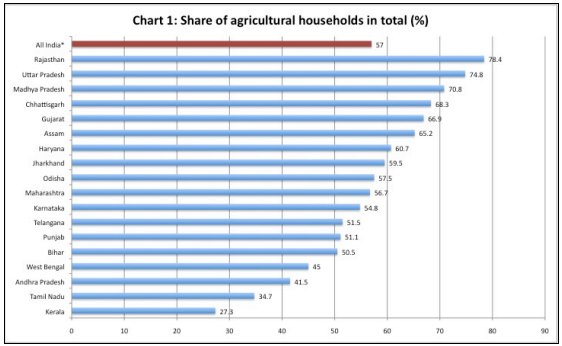
Rural Diversity and Diversification

Economic diversification in rural India, involving the emergence and growth of non-agricultural activities, is considered an important means of increasing employment and per capita incomes, and improving standards of living. However, non-agricultural activities themselves are of various kinds differing in terms of productivity and the returns they yield. So while the development of some activities may point to rural dynamism, many others exist and grow because of the distress-driven movement of those not absorbed in any productive activity, especially agriculture (despite the latter being the principal sink for the unemployed and underemployed in rural India). Failure to obtain decent work forces individuals with no social protection into any activity that helps avoid starvation. A typical example of the latter is that part of the retail trade which is undertaken with no proper premises and often even without a single location.
Evidence yielded by the latest National Sample Survey Organisation survey on the Situation of Agricultural Households in India (relating to January to December 2013) provides some evidence on the extent and nature of rural economic diversification. This edition of the survey defines an agricultural household rather broadly as any household that receives produce from agricultural activities (such as engagement in the cultivation of field crops or horticultural crops, in plantations or allied activities such as animal husbandry, fishing or bee keeping) valued at more than Rs. 3000 and has at least one member self-employed in agriculture as a principal or subsidiary activity.
The departure here from earlier similar surveys is that possession of land is not seen as a prerequisite for being classified as an agricultural household. Yet there were only 58 per cent of rural households that could be identified as agricultural households as per the “weak definition” adopted by the NSSO in its 70th Round. This is partly because even with this definition land possession was dominant among agricultural households. Landless households constituted only an estimated 0.1 per cent of all agricultural households in 2013. There were a mere 2.7 per cent of households (2. 4 million out of 90.2 million) that fell in the category that possessed less than 0.01 hectare of land. This was a category in which 70 per cent of the households had homestead land only and another 2.4 had no land whatever. So possession of land that could be operated for agricultural activities was quite the norm among agricultural households, even when more broadly defined. And in all size classes in terms of land possessed (except the lowest mentioned above), those that used land for some agricultural activity at some point during the year was 95 per cent or more.
One implication that could possibly be derived from this evidence is that there is a pretty sharp division between agricultural and non-agricultural households in rural areas. That view is corroborated by the evidence on the relative share of incomes derived from agriculture and allied activities. On average 68 per cent of the income of agricultural households comes from cultivation and allied agricultural activities, and 4.7 per cent and 22 per cent respectively from non-agricultural enterprises and wage and salaried employment. It is only in the lowest two land possession categories (less than 0.01 hectare, 0.01-0.4 hectare, and 0.41 to 1 hectare, respectively) that agricultural and allied incomes amounted to a relatively low 27 and 48 per cent respectively of total income, or where non-agricultural incomes exceeded one half of the total. In all the higher size classes (five in number) the share varied from 72 to 96 per cent.
The fact that households with little or no land are the ones that derive significant incomes from non-agricultural activities suggests that, among agricultural households, participation in non-agricultural activity is more distress driven than reflective of a purpose of dynamic diversification. This is not to say that households that possess no land but are engaged in high-productivity and modern manufacturing and services are absent. But with as much as 42 per cent of rural households across the country identified as non-agricultural, there is reason to suspect that a very large proportion of them would be in low productivity services or construction (as other evidence suggests).
Interestingly, only 38 per cent of households in the lowest asset class in terms of land possessed, held MGNREGS job cards, as compared with 44 per cent in the case of all agricultural households and 29 per cent in the case of the highest asset class. This is surprising also because the lowest size class in terms of land possessed was the one that reported the highest dependency on wage/salary employment. One explanation for this ‘anomaly’ at the all-India level could be the combination of differential success of MGNREGS implementation in different states and the pattern of land distribution in agricultural households in them.
Overall, the evidence points in two directions. First, that economic diversification in rural India is still largely distress driven. And, second, that non-agricultural activities of various kinds are replacing agriculture as the sink for unemployed or underemployed workers without social protection.
This is, of course, based on average data for the country as a whole. The share of agricultural households among rural households varied from 27 per cent in Kerala to 78 per cent in Rajasthan, and the mix of non-agricultural activities is likely to be very different across the states with important implications. But the aggregate national story is telling.
(The article was originally published in The Hindu, January 4, 2015)
